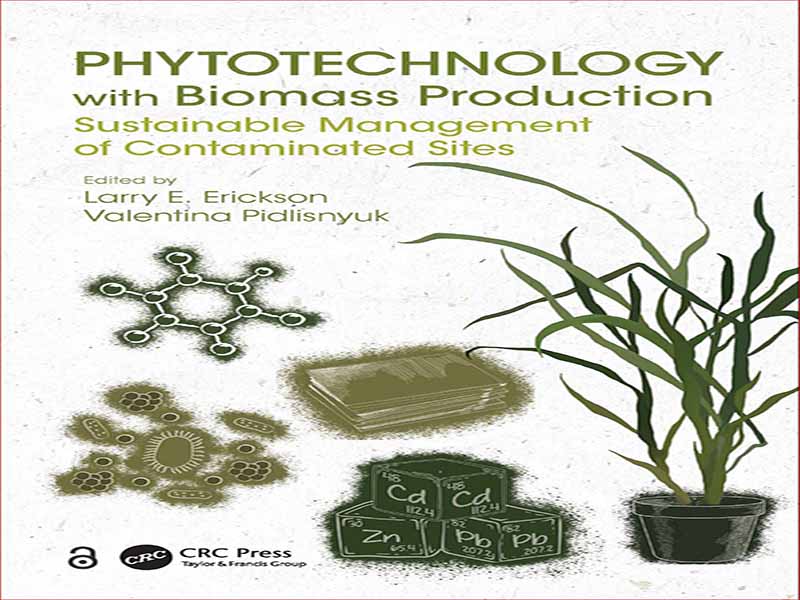- عنوان کتاب: Phytotechnology with Biomass Production
- نویسنده: Larry E. Erickson
- حوزه: فیتوتکنولوژی
- سال انتشار: 2022
- تعداد صفحه: 243
- زبان اصلی: انگلیسی
- نوع فایل: pdf
- حجم فایل: 26.5 مگابایت
مباشرت و مدیریت زمین از موضوعات مهم در منشور زمین و اهداف توسعه پایدار سازمان ملل است. فرآیندهای بهبود کیفیت خاک و کاربری زمین اهمیت جهانی دارند. تحقیق، توسعه و شیوههای اصلاح زمین با رویکردهای جدید در بسیاری از کشورها در حال پیشرفت است. از سال 1990 تا به امروز پیشرفت های زیادی در علم و مهندسی مربوط به فن آوری های گیاهی برای خاک های آلوده حاصل شده است. در فوریه 1989، مرکز تحقیقات مواد خطرناک دشت بزرگ/راکی کوهستان با دفتر مرکزی در دانشگاه ایالتی کانزاس و بودجه آژانس حفاظت از محیط زیست ایالات متحده تأسیس شد. تحقیقات در مورد اثرات مفید پوشش گیاهی در خاک های آلوده به یک محور مهم مرکز در چندین دانشگاه شرکت کننده تبدیل شد. یکی از پروژههای اولیه که شامل گیاه پالایی با تولید زیست توده بود، تأثیر درختان کاشته شده در لبه مزرعه را بررسی کرد تا میزان نیتروژنی را که هنگام خروج آب طوفان از میدان خارج میشود، به رودخانه کاهش دهد. از این شروع اولیه، تحقیقات زیادی برای توسعه فن آوری های گیاهی برای رسیدگی به مشکلات آلودگی در خاک و آب های زیرزمینی انجام شده است و نتایج گزارش شده است. تلاشها برای پیشرفت علم فنآوریهای گیاهی توسط انجمن بینالمللی فنآوری گیاهی و تعدادی رویداد بینالمللی از جمله کارگاه پژوهشی پیشرفته برنامه علم برای صلح و امنیت ناتو در اوکراین در سال 2007 کمک شده است. تجزیه و تحلیل اقتصادی نشان داده است که فناوری های گیاهی مقرون به صرفه ترین گزینه ها هستند زیرا کیفیت خاک بهبود یافته و هزینه های مرتبط با کاربردها پایین است. پنج مرکز تحقیقاتی مواد خطرناک توسط آژانس حفاظت از محیط زیست ایالات متحده برای رسیدگی به مشکلات آلودگی در جایی که نیاز به کاهش خطر بود، ایجاد شدند. بهسازی زمین یکی از اهداف مهم منشور زمین، اهداف توسعه پایدار سازمان ملل و سازمان غذا و کشاورزی سازمان ملل است. مکانهای زیادی وجود دارد که بهبود کیفیت خاک مفید است و استفاده از فنآوری گیاهی با تولید زیست توده ناشی از کاهش خطر نیست، بلکه بیشتر با هدف بهبود کیفیت خاک و بهرهوری سایت انجام میشود. با رشد جمعیت و نیاز به کاهش غلظت گازهای گلخانه ای در جو، نیاز است که از تمام زمین ها به طور موثر استفاده شود. در حال حاضر مکانهای زیادی وجود دارد که میتوان از فناوریهای گیاهی برای بهبود کیفیت خاک و استفاده بهتر از سایت استفاده کرد. در سال 2004 والنتینا پیدلیسنیوک از دانشگاه ایالتی کانزاس به عنوان بخشی از برنامه پژوهشی فولبرایت خود بازدید کرد. پس از این بازدید، تلاش های تعاونی مرتبط با فناوری های گیاهی با تولید زیست توده ایجاد و انجام شد. تهیه نسخه های خطی این کتاب یکی از فعالیت های پروژه تحقیقاتی چندساله G4687 برنامه علم برای صلح و امنیت ناتو با عنوان Phytotechnology for Cleaning Contamined Military Sites است. بسیاری از نتایج پروژه ناتو در مجلات با استنادات و منابع موجود در این کتاب منتشر شده است. محتویات کتاب شامل نتایج تحقیقات تکمیل شده به عنوان بخشی از پروژه ناتو و همچنین نتایج مطالعات دیگر است. از سال 1990 تا به امروز، پیشرفت زیادی در رابطه با سایت های دارای فلزات و سایت های دارای آلاینده های آلی صورت گرفته است. سایت های نظامی و زمین های آلوده به معادن، آفت کش ها، نفت و حلال های کلر را شامل می شود. یکی از دلایل استفاده از فناوری گیاهی با تولید زیست توده در سایتهای آلوده، بازگرداندن سایت به وضعیت مفیدی است که در آن زیست توده تولید میشود، بهبود کیفیت خاک اتفاق میافتد و کربن آلی در خاک جدا میشود. فرآیند استقرار پوشش گیاهی پس از بسته شدن یک سایت صنعتی یا سایت معدنی می تواند از اعمال اصلاحات خاک و تلاش برای اصلاح خواص فیزیکی خاک بهره مند شود. سلامت اکوسیستم را می توان از طریق درک بهتر جمعیت های بیولوژیکی و سهم آنها در سلامت خاک بهبود بخشید.
Land stewardship and management are important topics in the Earth Charter and United Nations Sustainable Development Goals. The processes to improve soil quality and land use have global importance. Research, development, and practices to remediate land are advancing with new approaches in many countries. Great progress has been made in the science and engineering related to phytotechnologies for contaminated soil during the years from 1990 to the present.
In February, 1989, the Great Plains/Rocky Mountain Hazardous Substance Research Center was established with headquarters at Kansas State University and funding from the U.S. Environmental Protection Agency. Research on the beneficial effects of vegetation in contaminated soil became an important thrust of the center at several of the participating universities. One of the early projects involving phytoremediation with biomass production investigated the impact of trees planted at the edge of the field to reduce the amount of nitrogen that goes into the stream when storm water flows off of the field. From this early start, much research to develop phytotechnologies to address contamination problems in soil and ground water has been conducted, and the results have been reported. The efforts to advance the science of phytotechnologies have been helped by the International Phytotechnology Society and by a number of international events including NATO Science for Peace and Security Program Advanced Research Workshop in Ukraine in 2007.
Economic analysis has shown that phytotechnologies are the most cost-effective options because soil quality is improved and costs associated with applications are low. The five hazardous substance research centers were established by U.S. Environmental Protection Agency to address contamination problems where risk needed to be reduced. Land improvement is an important goal of the Earth Charter, U.N. Sustainable Development Goals, and U.N. Food and Agriculture Organization. There are many locations where improvements in soil quality are beneficial and application of phytotechnology with biomass production is not driven by risk reduction, but rather by the goal of improving soil quality and site productivity. With the growth in population and the need to reduce the concentration of greenhouse gases in the atmosphere, all land needs to be used effectively. There are presently many locations where phytotechnologies can be applied to improve soil quality and make better use of the site.
In 2004 Valentina Pidlisnyuk visited Kansas State University as part of her Fulbright scholar program. After this visit cooperative efforts related to phytotechnologies with biomass production were established and carried out. The preparation of manuscripts for this book is one of the activities of the NATO Science for Peace and Security Program Multiyear Research Project G4687 entitled Phytotechnology for Cleaning Contaminated Military Sites. Many of the results of the NATO project have been published in journals with citations and references included in this book. The contents of the book include results from research completed as part of the NATO project but also results from other studies. From 1990 to the present, there has been a great progress related to sites with metals and sites with organic contaminants. Military sites and lands contaminated by mining, pesticides, petroleum, and chlorinated solvents are included.
One of the reasons to make use of phytotechnology with biomass production at contaminated sites is to restore the site to a useful state where biomass is being produced, soil quality improvement is happening, and organic carbon is being sequestered in the soil. The process of establishment of vegetation after an industrial site or mining site has been closed can benefit from the application of soil amendments and efforts to modify the physical properties of the soil. The health of the ecosystem can be improved through better understanding of the biological populations and their contributions to soil health.
این کتاب را میتوانید بصورت رایگان از لینک زیر دانلود نمایید.
Download: Phytotechnology with Biomass Production




































نظرات کاربران